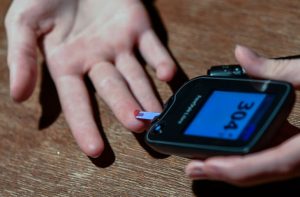Most doctors in diabetes recommend regular physical activity – it helps to normalize weight, lower blood cholesterol and blood pressure. However, we should not forget that physical activity, if not handled correctly, can be extremely dangerous. For patients with diabetes, the risk primarily lies in hypoglycemia – an excessive drop in blood glucose levels. Here it should be noted that hypoglycemia more often develops during treatment with sulfonylureas or insulin, while, for example, metformin is not dangerous in this respect.

Control of blood glucose levels
Dietary carbohydrates are absorbed into the blood, and most of them are stored as glycogen in the liver and muscles. During physical activity, working muscles actively consume glucose from the blood as well as from glycogen stores. In a healthy body, carbohydrate metabolism is well regulated, easily adapts to physical activity, and blood glucose levels remain within normal limits.
In diabetes, metabolic regulation is impaired, so blood glucose levels may fall below normal in response to exercise.
For example, if the diet and dose of antidiabetic drugs are chosen without regard to physical activity, and this activity began at a low level of glycemia (6 mmol/L or lower), muscle work will lead to hypoglycemia. If, on the contrary, blood sugar was slightly elevated before physical activity, then physical activity will lead to normalization of glycemia.
It would seem that physical activity might be the perfect way to lower blood sugar. However, it’s not that simple!
Glucose can only enter the cells when there is enough insulin – if physical activity is combined with a lack of insulin, the glucose content in the blood increases, but the substance cannot enter the cells of the body.
In this case, energy will be formed by breaking down fats – acetone will appear! If the glycemic level is too high – more than 13 mmol/l – physical activity is strictly contraindicated due to the danger of developing ketoacidosis.
If you are going to include any physical activity in your daily routine, you should first
- determine how your body will respond to it;
- Adjust your diet and doses of blood glucose-lowering drugs.
For the first time, you should be sure to monitor your blood glucose levels before the start of exercise, during the break, and at the end.
During the first period, you must monitor your blood glucose levels
Given the possibility of hypoglycemia, if your glucose level is less than 7.0 mmol/L, you should eat small amounts of slow digesting carbohydrates before exercising:
- cookies,
- a cheese sandwich,
- a few apples.
Another option is to reduce the dose in advance: blood glucose-lowering drugs or insulin.
If you are going to actively exercise, it is optimal to quench your thirst: an apple or apple or orange juice, diluted in half with water.
Also, when exercising, be sure to carry “fast” carbohydrates – sugar, fruit juice – to quickly relieve hypoglycemia.
It is important that hypoglycemia may occur within a few hours after stopping physical activity, so self-monitoring at this time is also mandatory.
If you had to engage in unplanned physical activity, such as moving furniture at work, blood glucose should be measured with a glucose meter during breaks and after physical activity to take action in time.
Under no circumstances should physical activity be combined with the intake of alcoholic beverages – acting together, these factors are more likely to provoke hypoglycemia.
What kind of sport to choose in case of diabetes
As for the type of sport, you need to choose dynamic (or in another way – aerobic) loads:
- running,
- walking,
- gymnastics,
- swimming.
Wrestling, boxing, lifting weights is undesirable for a diabetic.
Sports involving overload and uncontrollable situations should also be avoided, these include:
- mountain climbing,
- orienteering,
- sailing,
- parachuting.
As for the mode of exercise – it depends on the intensity of the load and the training of your body. The optimal duration is 30 minutes a day or, if you want to lose weight, an hour. Exercise time should be increased gradually.
Often diabetic patients also suffer from cardiovascular diseases, so if you have chest pain, palpitations, as well as dizziness and shortness of breath, exercise should be stopped immediately.

